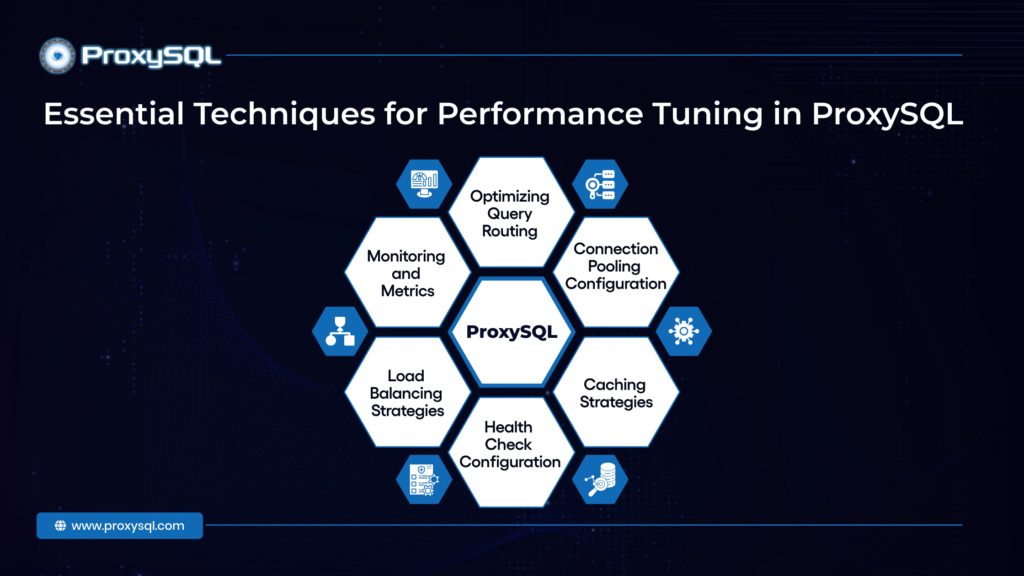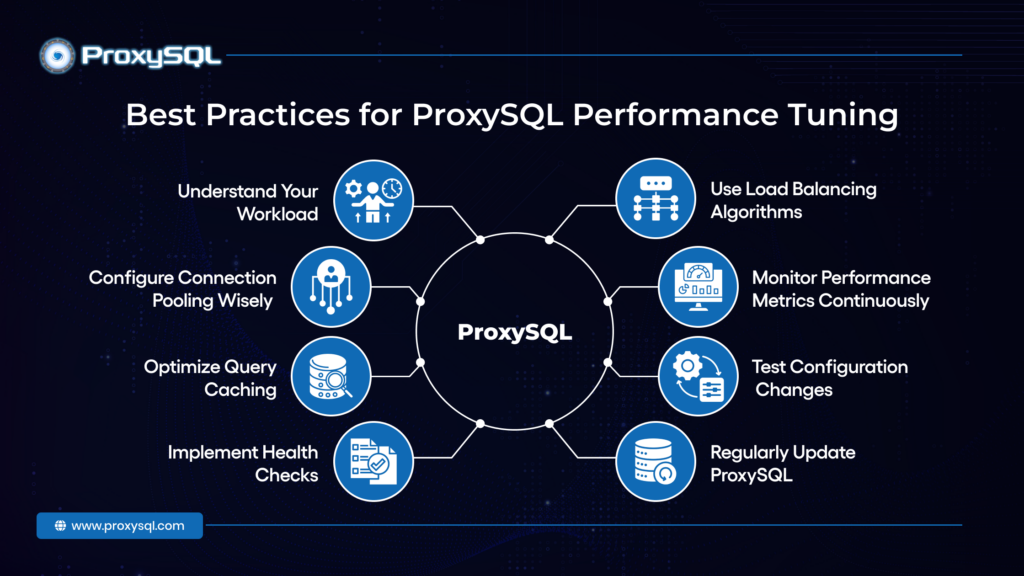Optimizing database interactions is critical to maintaining operational efficiency. According to Gartner, the global Database Management Systems (DBMS) market is projected to reach $203 billion by 2027, emphasizing the growing need for efficient database management solutions. A McKinsey report further highlights that organizations effectively managing their data can see 20% to 25% productivity gains.
As databases grow in size and complexity, performance tuning becomes essential for maintaining high performance within MySQL environments. In fact, organizations that optimize database performance can reduce costs by up to 30% while enhancing response times by nearly 50%, greatly improving user experiences.
ProxySQL is a key player that provides a powerful layer between your application and MySQL databases. However, even advanced tools like ProxySQL may fail to achieve their potential without proper performance tuning.
In this blog, we’ll explore fundamental performance tuning techniques to help you unlock ProxySQL’s full potential and ensure your databases run at peak efficiency.
Essential Techniques for Performance Tuning in ProxySQL

To fully utilize ProxySQL’s capabilities and maximize database performance, it’s beneficial to discuss the important techniques and advanced ProxySQL features that can significantly improve efficiency and reduce resource consumption. Each method plays a crucial role in ensuring the database system performs at its best, from optimizing query routing to fine-tuning connection pools.
Optimizing Query Routing
Effective query routing is essential for reducing latency and maximizing resource utilization. ProxySQL allows administrators to set specific rules based on query patterns, such as read and write separation.
You can optimize database performance by directing read queries to replicas and writing queries to the primary server. This method reduces the load on the primary server and enhances the overall response time for read operations, as multiple replicas can handle and share the load.
Connection Pooling Configuration
Connection pooling settings in ProxySQL play a vital role in enhancing performance. Fine-tuning parameters such as pool size and idle time can prevent connection overload on MySQL servers.
For instance, setting an appropriate timeout for idle connections can ensure that connections are released when not in use, improving overall resource efficiency. Additionally, connection multiplexing helps reduce the number of connections created, enabling more efficient management of resources. Properly managed connection pools minimize the overhead of creating and destroying connections, leading to faster query execution and better resource management.
Caching Strategies
Implementing caching can drastically reduce the number of queries hitting the database. ProxySQL provides query caching capabilities, allowing frequently executed queries to return results without contacting the backend database.
Configuring the cache size and expiration times can help organizations improve query response times and reduce database load. This proactive approach to caching can lead to significant performance improvements, especially in read-heavy applications.
Another strategy would be the use of ProxySQL to route queries requiring caching directly to caching specialised layers like ReadySet.
Health Check Configuration
Regular health checks on backend MySQL servers ensure that ProxySQL routes traffic only to healthy instances. Administrators can enhance system resilience by adjusting health checks’ frequency and timeout settings.
A well-configured health check system allows ProxySQL to detect failures promptly and reroute traffic accordingly, ensuring high availability. This capability is critical for maintaining uninterrupted service and minimizing downtime during server failures.
Load Balancing Strategies
Efficient load balancing is crucial for distributing traffic evenly across multiple MySQL servers. ProxySQL offers a complex load-balancing algorithm, based on round-robin, better latency, customized weight and least-connections, which can be tailored to meet specific workloads.
Selecting a suitable algorithm can optimize performance and reduce response times during peak traffic. Effective load balancing enhances performance and improves resource utilization and reliability across the database environment.
Monitoring and Metrics
Continuous monitoring is essential for identifying performance bottlenecks. ProxySQL provides built-in metrics that allow administrators to track performance indicators, such as query execution times and connection usage.
By analyzing these metrics, teams can make informed decisions about adjustments needed to enhance performance. Implementing a robust monitoring strategy enables proactive management of the database environment, ensuring that performance remains optimal over time.
Common Challenges in ProxySQL Performance Tuning
Configuration Complexity: The initial setup and configuration of ProxySQL can be complex, especially for organizations with intricate database architectures. Ensuring all parameters are correctly configured requires a deep understanding of ProxySQL and the underlying MySQL environment.
Overhead from Caching: While caching can improve performance, it may also introduce overhead if not correctly managed. Administrators must carefully balance cache size and expiration to avoid serving outdated data to applications.
Misconfigured Load Balancing: Inadequate load-balancing strategies can lead to uneven traffic distribution, causing some servers to become overloaded while others remain underutilized. Regular reviews of load-balancing configurations can help mitigate this risk.
Best Practices for ProxySQL Performance Tuning

Here are some best practices to ensure your ProxySQL deployment achieves optimal database performance:
Understand Your Workload
Before making any adjustments, it’s crucial to analyze the specific workload your application demands. Understanding the patterns of read and write queries will help configure ProxySQL effectively. Use metrics to identify peak usage times and the distribution of query types. This insight will inform decisions around query routing and load balancing.
Configure Connection Pooling Wisely
Connection pooling can significantly improve performance, but it must be configured appropriately. While there is no direct variable to set the pool size in ProxySQL, it can be achieved by adjusting the max_connections value for servers, in combination with other relevant variables like mysql-free_connections_pct. Based on workload analysis, set parameters such as mysql-max_transaction_idle_time to control idle connection timeouts.
For example, a larger max_connections value may benefit high-traffic applications, while a smaller one might suffice for less demanding environments. Monitoring connection usage over time can help refine these and other settings to ensure optimal performance.
Optimize Query Caching
ProxySQL supports query caching, which can significantly reduce the load on your backend databases. Implement caching for frequently executed queries and fine-tune the cache size and expiration settings. A well-optimized caching strategy can improve response times and reduce latency, making it an essential performance tuning component.
Implement Health Checks
Regular health checks are vital for maintaining high availability. Configure health checks to run at appropriate intervals and adjust timeout settings based on the responsiveness of your backend servers. This proactive approach allows ProxySQL to redirect traffic away from failing servers, minimizing potential downtime.
Use Load Balancing Algorithms
ProxySQL provides various ways to manage load balancing, including adjusting server weights within a hostgroup to influence traffic distribution. By modifying server weights, you can make sure to shift traffic toward specific nodes based on preconditions known by the administrator..
For instance, adjusting server weights can help evenly distribute requests or prioritize servers with fewer active connections for resource-intensive queries.
Monitor Performance Metrics Continuously
Monitoring is a continuous process that helps to identify performance bottlenecks. Use ProxySQL’s built-in metrics to track query execution times, connection usage, and caching efficiency. Review these metrics regularly to make informed decisions and adjustments as needed, ensuring optimal performance.
Test Configuration Changes
Before deploying significant changes to production, test your configurations in a staging environment. This practice allows you to evaluate the effects of your adjustments on performance without risking the stability of your live environment. Conduct performance tests under load to measure the impact of tuning efforts.
Regularly Update ProxySQL
Staying up-to-date with the latest ProxySQL releases ensures access to performance improvements, bug fixes, and new features. Regular updates help maintain optimal performance and security in your database environment.
By following these best practices, you can effectively tune ProxySQL to maximize database performance and reliability, ensuring your systems are well-equipped to handle varying workloads and demands.
Optimize Your Database Performance with ProxySQL!

ProxySQL provides an innovative solution to enhance MySQL performance through intelligent query management and robust connection handling.
With ProxySQL, you get:
- Dynamic Load Balancing: Ensure efficient query distribution across your MySQL servers, reducing response times and preventing overload.
- Advanced Caching Mechanisms: Caching frequently executed queries significantly minimizes database load, leading to faster access and improved user experience.
- Real-Time Monitoring: Use built-in metrics to track performance indicators, continuously enabling proactive adjustments and optimizations.
Integrating ProxySQL into your database infrastructure can unlock unparalleled performance and reliability, allowing your applications to scale seamlessly under increased demands.
Are you ready to take your database performance to the next level? Start optimizing today with ProxySQL! Learn more about ProxySQL performance tuning and transform your database capabilities.